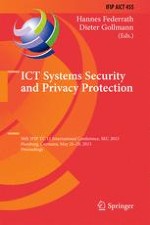2015 | Book
ICT Systems Security and Privacy Protection
30th IFIP TC 11 International Conference, SEC 2015, Hamburg, Germany, May 26-28, 2015, Proceedings
Editors: Hannes Federrath, Dieter Gollmann
Publisher: Springer International Publishing
Book Series : IFIP Advances in Information and Communication Technology
